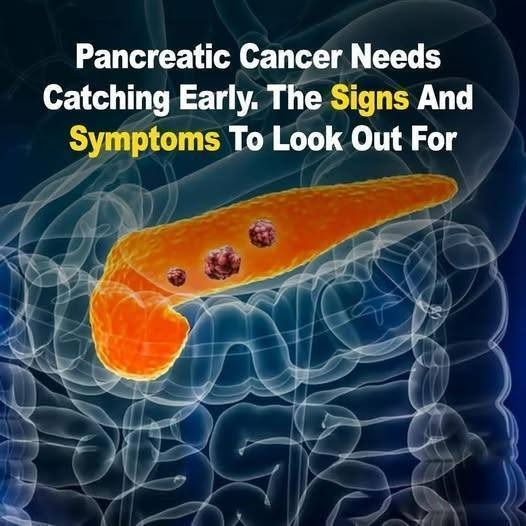
Pancreatic cancer is often called a “silent disease” — not because it causes no symptoms, but because its early signs are vague, gradual, and easily mistaken for other, less serious conditions.
It’s true: pancreatic cancer is difficult to detect early.
The pancreas lies deep in the abdomen, and there is no routine screening test for average-risk individuals.
But here’s what you should know:
It does send signals — especially as it progresses.
And while no single symptom means you have cancer, being aware of persistent changes can help you seek care sooner, when treatment may be more effective.
Let’s explore 10 symptoms associated with pancreatic cancer — so you can understand them clearly, calmly, and without fear.
Because real awareness isn’t about panic.
It’s about paying attention to your body — wisely and promptly.
What Is the Pancreas — And Why Does It Matter?
The pancreas is a small, banana-shaped organ behind the stomach that plays two vital roles:
Digestive function: Releases enzymes to break down food
Hormone production: Makes insulin to regulate blood sugar
When something goes wrong — like tumor growth — these functions can be disrupted… slowly at first.
⚠️ 10 Symptoms That May Be Linked to Pancreatic Cancer
These signs don’t mean you have cancer — but if they’re new, unexplained, and persistent, they deserve medical attention.
1. Jaundice (Yellowing of Skin or Eyes)
Often one of the first noticeable signs
Caused by a tumor blocking the bile duct
May also cause dark urine and pale stools
✅ Important: Jaundice without fever or known liver illness should be evaluated immediately.
2. Unexplained Weight Loss
Losing 10+ pounds without trying
Happens due to poor digestion, reduced appetite, or cancer metabolism
Common in many illnesses — but concerning when paired with other symptoms.
3. Abdominal or Mid-Back Pain
Dull, constant ache in the upper abdomen that radiates to the back
Often worse after eating or lying down
Not typical indigestion — this pain persists and may worsen over time.
4. New-Onset Diabetes After Age 50
The pancreas controls insulin — tumors can disrupt this
Sudden diagnosis of diabetes without family history or obesity may be a red flag
Studies show new diabetes can be an early sign of pancreatic cancer in some people.
5. Loss of Appetite or Feeling Full Quickly
Bloating, nausea, or lack of hunger despite not eating
Due to impaired digestive enzyme release
✅ If lasting weeks, see a doctor.
6. Light-Colored, Greasy Stools (Steatorrhea)
Foul-smelling, float, hard to flush
Happens when the pancreas can’t release enough enzymes to digest fat
A key sign of exocrine pancreatic dysfunction.
7. Itchy Skin
Often linked to jaundice and bile buildup
Can occur before yellowing becomes visible
8. Blood Clots (Deep Vein Thrombosis)
Unexplained leg swelling, pain, or warmth
Pancreatic cancer increases clotting risk — sometimes appearing before diagnosis
⚠️ Blood clots require immediate medical care.
9. Fatigue That Won’t Go Away
Persistent exhaustion despite rest
Can result from cancer-related inflammation, poor nutrition, or anemia
Not diagnostic alone — but significant when combined with other symptoms.
10. Changes in Mood or Depression
Some patients report new-onset depression months before diagnosis
Exact link unclear — may be biological or psychological
Still worth noting if sudden and unexplained.
✅ Who Is at Higher Risk?
✅ Age over 55
Most cases diagnosed after age 65
✅ Smoking
Doubles the risk — one of the top preventable causes
✅ Chronic Pancreatitis
Long-term inflammation raises risk
✅ Family History
Genetic syndromes (like BRCA2) increase susceptibility
✅ Obesity & Diet
Poor diet and excess weight contribute to risk
✅ Diabetes
Long-standing type 2 increases risk slightly
High-risk individuals may benefit from specialized monitoring — talk to your doctor.
❌ Debunking the Myths
❌ “Only smokers get pancreatic cancer”
False — non-smokers can develop it too
❌ “All belly pain means cancer”
No — most abdominal issues are unrelated
❌ “There’s nothing you can do”
Not true — quitting smoking, healthy weight, and early evaluation improve outcomes
❌ “You’d know immediately if something was wrong”
Dangerous myth — symptoms are often subtle at first
✅ What You Can Do to Reduce Your Risk
Quit smoking
One of the most impactful actions you can take
Eat a plant-forward diet
Rich in fruits, vegetables, whole grains
Stay physically active
Helps regulate insulin and reduce inflammation
Maintain a healthy weight
Reduces strain on the pancreas
Limit alcohol
Heavy drinking increases pancreatitis risk
Get regular check-ups
Especially if you have risk factors
Early detection saves lives — but only through medical testing (imaging, blood work).
When to See a Doctor
Don’t wait if you experience:
Persistent jaundice
Unexplained weight loss + abdominal pain
New diabetes with other digestive symptoms
Light-colored stools or dark urine
Your primary care provider may refer you to a gastroenterologist or order imaging (CT, MRI, endoscopic ultrasound) if needed.
Final Thoughts
You don’t need to live in fear of every ache or change.
But if something feels off — and doesn’t go away — trust your gut.
Pancreatic cancer is rare compared to other cancers, but awareness matters.
So if you’re noticing persistent symptoms…
don’t ignore them.
Talk to your doctor.
Ask questions.
Get answers.
Because real courage isn’t about avoiding hard truths.
It’s about facing them — early, honestly, and with hope.
And that kind of strength?
It starts with one brave conversation.